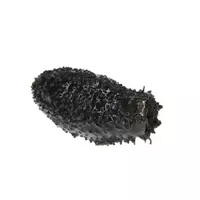Cucumaria

In Japan, they say that "a night of good sleep prolongs life by three days, and just one dish of cucumaria will add another month. " Cucumaria or Cucumaria belongs to the class of holothuria and the genus echinoderms. This inhabitant of the deep sea differs in its appearance. In the natural habitat, the body of the cucumaria has an elongated shape. However, during the mining process, the appearance of the cucumaria undergoes significant changes. The dark purple and even brown elongated body of the cucumaria shortens and becomes spherical.
On the abdomen of the cucumaria there is a huge number of ambulacral legs, which, if necessary, can be easily drawn into the body. In the history of industrial extraction and harvesting of cucumaria, cases of giant echinoderms in size were recorded, which reached 40 cm in length and weighed up to 1 kg. Believe me, for such a small inhabitant of the deep sea as cucumaria, such dimensions are not just a record, this is a real exception to the rule.
Kukumaria lives in the Barents, Japan and Okhotsk seas. Often, cucumaria descends to a depth of 100 meters. It feeds on cucumaria particles of silt. Cucumaria is considered the closest relative of trepang mollusks. Seafood is really similar in taste, appearance and even in the chemical composition of meat. Trepang is often confused with kukumaria. It is noteworthy that the name of the cucumaria translates as "sea cucumber. " Often in the literature it is the trepangs that are called, and not the kukumaria.
The beneficial properties of cucumaria are expressed in the chemical composition of seafood, which is rich in vitamins, minerals and other biologically active substances of natural origin. The healing properties of cucumaria have long been used in oriental medicine. It was believed that eating cucumaria daily could cure severe ailments and put hopeless patients on their feet. Kukumaria meat is most popular in Japan.
In the land of the rising sun, kukumaria is really loved and appreciated, as evidenced by the huge number of recipes for preparing seafood. Cucumaria meat is stewed, fried, boiled, baked, marinated, dried and preserved. It is a versatile and useful seafood product. In addition, extracts and extracts are isolated from cucumaria, which are subsequently used for the production of drugs.
It is noteworthy that in our latitudes you can buy kukumaria without any problems, since the Russian Federation, along with Japan, are considered the largest harvesters of seafood. Residents of the Far East have long consumed cucumaria meat for food. However, in the central part of the Russian Federation, many have never even heard of such a "miracle yudo" product as kukumaria. Perhaps the time has come to pay closer attention to a healthy and tasty seafood.
kukumaria 34.6 kCal
Energy value of cucumaria (Ratio of proteins, fats, carbohydrates - ju):
Proteins: 7.3 g (~ 29 kCal)
Fats: 0.6 g (~ 5 kCal)
Carbohydrates: 0 g (~ 0 kCal)
Energy ratio (bj | y): 84% | 16% | 0%
 Español
Español Français
Français Português
Português Русский
Русский 简体中文
简体中文 繁體中文
繁體中文 日本語
日本語 한국어
한국어 العربية
العربية Türkçe
Türkçe Қазақ
Қазақ Deutsch
Deutsch Italiano
Italiano Українська
Українська
